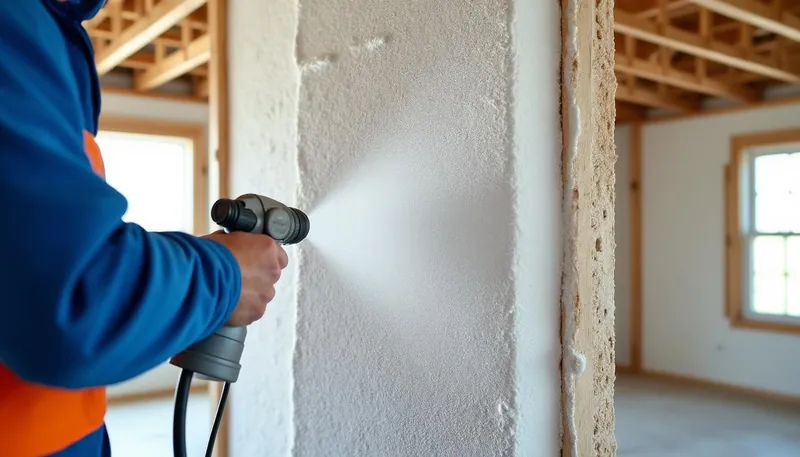In recent years, the focus on sustainability and eco-friendliness has surged within the construction industry. Homeowners and builders alike are seeking insulation materials that not only diminish energy consumption but also minimize their environmental impact. Among the various options available, foam insulation has garnered attention for its energy efficiency and potential eco-credentials. But, is foam insulation truly environmentally friendly? We will delve into this question and explore the landscape of eco-friendly spray foam insulation, examining its benefits, manufacturing processes, and whether it can hold its ground as a sustainable choice in today’s building projects.
Brief
- Foam insulation offers significant energy efficiency, contributing to reduced energy consumption in homes and buildings. 🔋
- The eco-friendliness of foam insulation hinges on low-VOC and renewable materials used in its production. 🌱
- Closed-cell foam insulation provides superior air sealing and moisture resistance. 🔒
- Understanding factors like R-value, lifecycle analysis, and installation impact is crucial for assessing sustainability. 📊
- Choosing the right eco-friendly insulation can lead to long-term cost savings and a healthier indoor environment. 💰
Understanding Eco-Friendly Spray Foam Insulation
Spray foam insulation is a modern contender in the realm of insulation materials, offering a revolutionary approach to energy efficiency and thermal comfort. When properly installed, foam insulation can create a robust barrier against air leaks, contributing to reduced energy consumption. This energy efficiency is pivotal, considering that the US Department of Energy indicates that approximately 44% of energy use in homes goes towards heating and cooling.
In essence, there are two primary types of spray foam insulation: closed-cell and open-cell foam. Both products have unique characteristics that influence their suitability for various applications. Understanding these differences is key to making an informed choice.
Closed-Cell vs. Open-Cell Foam Insulation
Closed-cell foam is dense and hard, boasting an impressive R-value that ranges from R-5 to R-7 per inch. This high R-value signifies its excellent insulation properties, making it ideal for climates where moisture is a concern. The density of closed-cell foam also creates a moisture barrier, effectively preventing mold growth and structural damage in areas like attics and basements.
Open-cell foam, in contrast, is softer and more flexible. Its R-value is slightly lower, typically between R-3.5 and R-4 per inch, but it allows for better airflow. This can be beneficial in certain applications, as it helps reduce pressure build-up in the walls. The choice between these two types often hinges on the specific needs of a structure and its environmental conditions.
| Type of Foam | Dense | R-Value (per inch) | Application Areas | Moisture Resistance |
|---|---|---|---|---|
| Closed-Cell Foam | Yes | R-5 to R-7 | Attics, Basements | High |
| Open-Cell Foam | No | R-3.5 to R-4 | Walls, Ceilings | Low |
The Environmental Impact of Foam Insulation
When examining foam insulation’s eco-friendliness, we must consider both the materials used in production and the overall lifecycle of the product. Insulation is fundamentally about energy conservation, and effective goods can lead to considerable savings in heating and cooling costs. But how does foam insulation stack up in terms of environmental impact?
Recycling and Renewal
Modern manufacturers like EcoFoam and GreenGuard have recognized the importance of sustainability in their product offerings. Many spray foam products are now composed of low-VOC materials and renewable sources, which significantly reduces their environmental footprint during both production and installation. For example, NatureFoam emphasizes its use of plant-based materials in its formulations, ensuring a cleaner process overall.
While the benefits of foam insulation are clear, it’s equally important to consider the carbon footprint associated with its production, application, and eventual disposal. A detailed lifecycle analysis can help homeowners and builders evaluate how eco-friendly a specific product truly is. Companies like EarthWise Insulation are pioneering more thorough assessments of their products’ environmental impacts from raw material extraction to end-of-life management.
| Factor | Impact | Comment |
|---|---|---|
| Carbon Footprint | Varies | Depends on material choice and production methods. |
| Energy Use During Production | High | Foam production can be energy-intensive. |
| End-of-Life Options | Limited | Recycling options can be sparse compared to other materials. |
Selecting the Right Eco-Friendly Foam Insulation
In making the choice for eco-friendly insulation, it’s crucial to navigate a variety of factors. Not only should energy efficiency and cost savings be on your radar, but you’ll want to consider the product’s environmental credentials as well.
Key Considerations
- R-Value: Aim for materials offering higher R-values as they provide better insulation. 🔍
- Environmental Impact: Investigate the materials and processes of production. Choose brands that emphasize low-VOC and renewable options. 🌍
- Installation Expertise: Proper installation can significantly impact effectiveness, and professional help is often the best route. 🛠️
- Cost: Weigh upfront costs against long-term savings in energy bills. 💲
Product offerings such as SafeTouch and BioFoam Solutions are helping to redefine insulation for eco-conscious consumers, ensuring that performance and sustainability are no longer mutually exclusive.
Emerging Trends and Technologies in Foam Insulation
The trend towards using eco-friendlier materials in construction is growing rapidly, and the insulation sector is no exception. Innovations in foam insulation technology have surfaced, leading to more effective and environmentally sound solutions.
Innovative Solutions
Among the latest developments, SustainableFoam has introduced formulations that utilize organic compounds, allowing them to achieve optimal R-values while minimizing their ecological footprint. These innovations often address the challenges presented by traditional insulation materials, which can carry health risks or environmental hazards.
Furthermore, system advancements such as EnviroSeal are optimizing air sealing capabilities, which enhances the already formidable thermal protection that foam offers. These features come hand-in-hand with reduced energy bills, giving profoundly beneficial results for homeowners.
| Brand | Innovation | Benefit |
|---|---|---|
| SustainableFoam | Organic formulations | Higher R-values with reduced ecologic impact. |
| EnviroSeal | Enhanced air sealing | Improved energy efficiency and lower bills. |
Is foam insulation environmentally friendly?
The eco-friendliness of foam insulation depends on its materials and production processes. Low-VOC and renewable options contribute to its sustainability.
What advantages does foam insulation offer?
Foam insulation provides significant energy efficiency, reducing heating and cooling costs while improving indoor comfort.
How do I choose eco-friendly foam insulation?
Look for high R-values, low environmental impact, and reputable brands focused on sustainability.


